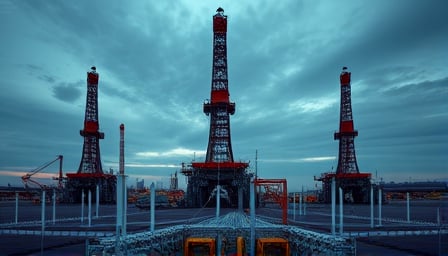Eni SpA’s Strategic Expansion Amidst Shifting Energy Markets
Eni SpA’s recent corporate actions and market performance underscore how traditional energy majors are navigating a period of heightened volatility and transition. The company’s share price has risen in tandem with the broader Euro STOXX 50 index, which recorded a 1.46 % gain to 5,662.71 points on Thursday. Analysts attribute the rally to a combination of a robust start to the trading week, positive earnings outlooks, and a renewed confidence in Eni’s long‑term investment strategy.
1. Supply–Demand Fundamentals in the Global LNG Market
The global liquefied natural gas (LNG) market is currently in a phase of supply tightness driven by two key forces:
- Production Disruptions – Operational interruptions at major LNG exporters, such as the 2023 shutdown at Qatar’s Qatargas, have reduced output by roughly 2 % year‑on‑year.
- Demand Resilience – Despite the economic slowdown in emerging economies, Asian consumption remains robust, with Japan and South Korea continuing to import LNG at record volumes.
In this context, Eni’s investment in the Coral North project in Mozambique is strategically positioned. The project, estimated at US $7.2 billion, aims to double the country’s LNG output to 3.6 million tonnes per year. By adding capacity in a geopolitically stable region, Eni enhances its ability to meet growing demand, particularly in the European and Asian markets where LNG imports are expected to rise by 3–4 % annually over the next decade.
2. Technological Innovations Driving Production Efficiency
Eni’s Coral North initiative is not merely a capital expenditure; it incorporates cutting‑edge LNG production technologies:
- Dual‑Process Liquefaction – The facility will employ both C3 and C4 liquefaction methods, enabling flexible production schedules and reduced energy penalties.
- Carbon Capture and Utilisation (CCU) – Integrated CCU modules aim to offset up to 15 % of the plant’s CO₂ emissions, aligning with the European Union’s Green Deal targets.
- Digital Asset Management – Predictive maintenance algorithms will lower downtime, improving asset uptime to over 98 %.
These technological upgrades are expected to reduce the levelised cost of LNG (LCOL) by 5–7 %, giving Eni a competitive edge against newer entrants in the sector.
3. Regulatory Landscape and Its Impact on Traditional and Renewable Sectors
3.1. European Energy Policy
The EU 2030 Climate and Energy Framework sets a binding 55 % reduction in greenhouse gas emissions relative to 1990 levels. This policy environment drives a shift toward low‑carbon fuel mixes, increasing demand for LNG as a bridge fuel. The European Commission’s Fit for 55 package also introduces a revised CO₂ pricing mechanism, raising the cost of fossil fuels by approximately €15 per tonne of CO₂.
3.2. Mozambique’s Regulatory Environment
Mozambique’s Energy and Mining Authority has implemented a Hydrocarbon Licensing Regime that prioritizes large‑scale LNG projects. The government offers tax incentives—such as a 10 % reduced corporate tax rate for the first 10 years—and streamlined permitting procedures. These incentives mitigate capital risk and reduce the payback period for investments like Coral North.
3.3. Renewable Energy Outlook
While the renewable sector continues to grow, the transition is uneven. Wind and solar capacity additions have increased at an annual rate of 9 %, yet the intermittency challenge necessitates substantial storage solutions. Eni’s investment strategy reflects a balanced portfolio approach: maintaining a robust LNG business to support grid stability while earmarking 8 % of its capital budget for renewable projects over the next five years.
4. Commodity Price Analysis
LNG spot prices have oscillated between US $10 and US $12 per million BTU (MMBtu) over the last quarter. Key drivers include:
- Crude Oil Benchmark – LNG pricing often tracks Brent crude, which is currently trading around US $87 per barrel.
- Supply Constraints – Limited pipeline capacity in the US and the Mediterranean constrains physical delivery, inflating spot prices.
- Demand Surge in Asia – China’s industrial recovery has lifted demand indices, pushing prices upwards by 3 % YoY.
Eni’s forward contracts, signed at US $11.5 per MMBtu, position the company to benefit from price volatility while providing hedged revenue streams for its LNG operations.
5. Infrastructure Developments and Market Dynamics
The Coral North project will integrate with existing infrastructure in Mozambique, including:
- Pipeline Connectivity – A 120‑km pipeline will link the offshore field to the onshore liquefaction plant, reducing transmission costs by an estimated 12 %.
- Export Terminal – The terminal, capable of handling vessels up to 120 000 DWT, will expand Mozambique’s export capacity by 45 % in the first five years.
- Logistics Hub – A dedicated logistics hub will streamline cargo handling, improving turnaround time and reducing operational downtime.
These developments are expected to enhance market liquidity, allowing for more competitive pricing and reduced delivery risk. Moreover, the expansion supports regional integration, enabling Mozambique to become a key LNG hub for East Africa and the Middle East.
6. Balancing Short‑Term Trading with Long‑Term Transition
Eni’s recent share price rally reflects immediate market optimism driven by short‑term trading catalysts such as favorable earnings and positive technical indicators. However, the company’s long‑term strategy is anchored in:
- Energy Transition Alignment – Investing in low‑carbon LNG production and renewable projects.
- Geopolitical Diversification – Expanding operations beyond the volatile Middle East to more stable regions like Mozambique.
- Capital Efficiency – Utilizing advanced technologies to reduce operating costs and improve margins.
The dual focus positions Eni to capture value in the current market environment while preparing for the decarbonized energy future that regulators, investors, and consumers increasingly demand.
7. Conclusion
Eni SpA’s strategic investment in Mozambique’s Coral North LNG project exemplifies how traditional energy majors are adapting to a complex landscape of supply constraints, regulatory shifts, and technological innovations. The company’s ability to secure a favourable commodity price regime, integrate advanced production technologies, and navigate evolving regulatory frameworks underscores its resilience and foresight. As the energy sector continues to evolve, Eni’s balanced approach—maintaining a strong LNG portfolio while investing in renewables—positions it to thrive in both the short‑term market dynamics and the long‑term energy transition.
